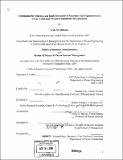Optimizing the selection and implementation of assembly line equipment at a large automobile original equipment manufacturer
Author(s)
Holman, Cale M. (Cale Matthew)
DownloadFull printable version (10.15Mb)
Other Contributors
Leaders for Manufacturing Program.
Advisor
Charles Fine and Daniel Whitney.
Terms of use
Metadata
Show full item recordAbstract
Toyota Motor Manufacturing North America (TMMNA) is continuing to face an increasingly competitive automobile market. To meet these evolving market conditions, TMMNA has experienced rapid growth in demand for its automobiles in North America. To meet this demand, Toyota has rapidly grown from three assembly plants in the mid- 1990's to its current total of six assembly plants (five in operation with one being built). This has led to many management challenges, including communication, knowledge sharing, and knowledge retention that many companies experience when faced with rapid growth. In order to respond to these challenges, Vehicle Production Engineering (VPE) Assembly, a department within TMMNA, has attempted to develop a process through which it can standardize its processes and capitalize on best practices across the many North American plants. This thesis studied the process through which VPE Assembly develops and installs assembly line equipment for major automobile model changes. This study included observation of the Toyota product development process and how this process is carried out within VPE Assembly. This research revealed that the assembly line equipment process employed by Toyota is well suited for this organization. However, there are improvements available that could improve the overall process and bring automobiles models to the market more quickly. Communication between the different plants could be improved. Additionally, much knowledge learned from completed projects is not being shared fully between the various plants. Suggested improvements to address these problems are discussed.
Description
Thesis (M.B.A.)--Massachusetts Institute of Technology, Sloan School of Management; and, (S.M.)--Massachusetts Institute of Technology, Dept. of Ocean Engineering; in conjunction with the Leaders for Manufacturing Program at MIT, 2005. Includes bibliographical references (p. 96-97).
Date issued
2005Department
Leaders for Manufacturing Program at MIT; Massachusetts Institute of Technology. Department of Ocean Engineering; Sloan School of ManagementPublisher
Massachusetts Institute of Technology
Keywords
Sloan School of Management., Ocean Engineering., Leaders for Manufacturing Program.